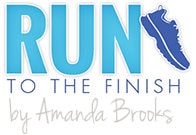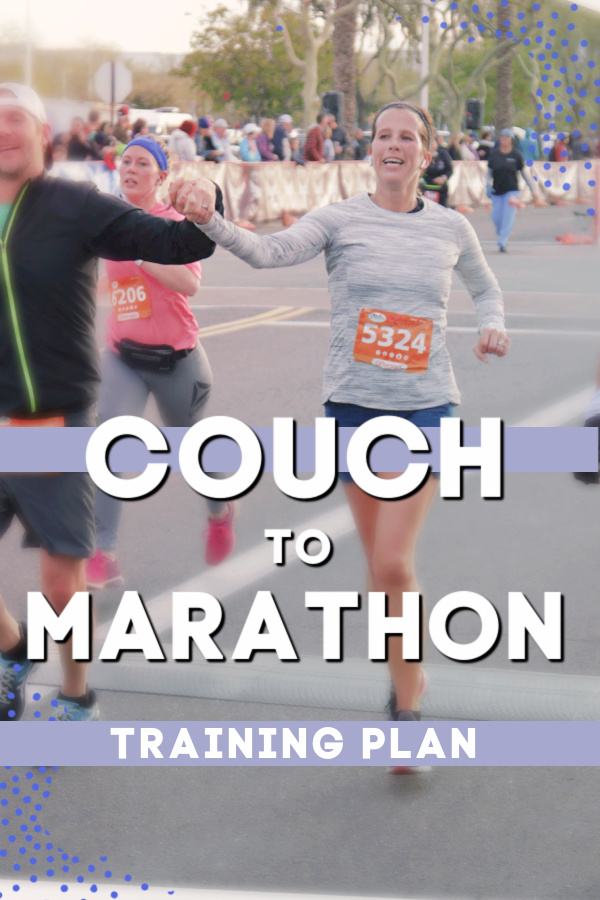You’ve finally taken the leap and hit register, when reality sets in…this amazing goal needs a plan. Welcome to the Couch to Marathon training plan, we’re here to help guide you through the next six months and make sure you can throw your hands up victoriously at the finish.
Can You Train for a Marathon in 6 Months?
Yes. It’s not always my favorite thing for runners to do, but it’s 100% POSSIBLE if you follow a plan and choose to be smart about training and setting appropriate goals.
Remember the goal of a first marathon is just to finish injury free! One of the most common and preventable running injuries is shin splints. FOLLOW the plan without adding a lot of mileage to stay feeling good.
How Quickly Can You Go From Couch to Marathon?
Like every question in running there are a lot of factors here from fitness history, to injuries, to age, to overall health. Realistically this 24 week plan is the fastest that I want to see most people go from being inactive to completing 26.2 miles.
Why?
If you get injured or burned out or completely frustrated then you’ll stop all together. And all 3 are highly possible when we try to rush the process.
It’s not just that your mind has to adapt to all the time on the road, but your bones, joints, ligaments, tendons, lungs and cardiovascular system need time to adapt. It’s a new strain they are being put under and it doesn’t just happen faster because we want it to.
As a running coach, in my ideal world, I love to see people running for at least a year injury free before tackling the marathon. That allows you to do some half marathons, learning so much about fueling and pacing and strength that the marathon training then feels more doable.
Couch to Marathon Training Plan
I won’t waste time, if you’re here for a plan then you can get it ASAP at the link below.
But I hope you’ll read on for some training tips to ensure this isn’t a dreadful experience.
Training Plan Notes
A few important things to explain what you’ll find on the plan so you can get the most from it.
Easy runs mean that you can carry on a conversation. If you are huffing and puffing you’re going too hard.
You have to learn how to run easy to increase your mileage and that usually means starting out with run/walk intervals. Overtime you’ll improve your fitness and be able to lessen the walk time and increase the run time.
Hill sprints are to be done at the end of a run and are designed to help you build leg strength for power and speed with less chance of injury.
Intensity remains fairly low on the whole for this Couch to Marathon plan. The idea is to first build a strong foundation and then to introduce speed workouts, while still keeping them at 20% or less of your total mileage.
Our goal is not a blazing fast race, it’s ensuring that you can complete the training and show up at the start line ready to go!
Training Schedule
Don’t get too fixated on what days are currently listed. If you need to do your long run on Friday, then just shift things around a bit to ensure that you are getting your rest day in as well.
In this plan, I put the longer workout on Saturday and then initially a walk on Sunday. This is to help you keep moving on tired legs and get used to that feeling. We also know that some movement for novice to elite runners can help the legs feel better.
For first-time marathoners we aren’t going to be worried about things like tempo run or event goal pace miles. So don’t freak out when you hear others talking about that. You just need to work on building endurance.
Who is the Couch to Marathon Guide For?
I’ve designed this so that it can be used by the brand new runner, the person calling themselves out of shape and scaled up for someone who has some fitness but isn’t really running.
- Scaling up the plan means you might move through run/walk times faster (i.e. using 8/1 instead of 4/1) or it might mean that you can do just a little bit more on the long runs
- Don’t try to cram in additional miles or make up runs, that’s a great way to get injured
- Remember that run/walk marathon training is a tool used even by experienced runners
Couch to Marathon Training Guide
At a minimum I’d like to see you have 6 months of training, ideally I’d be way more excited if you were willing to give it a full year…but since you’re here that’s unlikely and I get it!
Why do we want more time than you might expect for training?
- Your muscles, joints and tendons have to adapt to the new increased stress
- Jumping mileage too quickly leads to injuries, which means no training and no race
- Over this time you’ll learn how to be consistent, how to fuel properly and recover
- Marathon training is not just running.
Ohhhhh, that last one got your attention didn’t it.
It seems like all you need to do is run more. And that’s not entirely wrong, but it’s missing a lot of nuance. We absolutely must strength train, that’s the piece that keeps us from having knee pain and hip pain.
We absolutely must learn how to fuel during those long runs so we don’t hit the wall, so we can recover and be able to keep doing the next assigned workout.
If all of that sounds like a lot, it is!! This is why I keep saying, give it time and don’t be afraid to ask for help from a running coach. Getting a coach for your first marathon might just be the thing that keeps you running for many years to come.
3 Quick Tips for Couch to Marathon Training
I have tons of articles on every aspect of marathon training, so I can’t summarize them all here.
BUT let’s look at a few of the key pieces which will get you through training injury free and much stronger than you might anticipate.
BOOK MARK THIS PAGE – come back during training to keep learning and making your runs better.
1. Dynamic Warm Up
Never. Ever. Start Running…without a warm up.
No, not sometimes. Never.
- loosens up tight muscles
- lubricates joints
- gets the body prepped to run
- sends signals to the brain that you’re ready to run
- IMPROVES ENDURANCE
- Dynamic Warm Up Movements
That’s right. If you’ll give me 7-10 minutes pre-run then you will find that you can actually run farther before you start to feel winded.
Runners who train with us have consistently reported by time and time again that it blows their minds how much better their runs go after adding in a dynamic warm up.
2. Core Strength
This is not about getting you sprinter abs, this is about getting glutes, hips and abs that will keep you injury free.
95% of running injuries come from lack of strength or imbalances in theses areas and you have the ability to PREVENT that by putting in just a little bit of time.
- 30 Day Core Runner Program – don’t know where to start this gives you 10 minutes a day and leads to running faster and less injuries
- Add glute bridge marches and single leg bend and reach to your dynamic warm up
- Stop holding planks for 2 minutes and start doing planks that require stabilization like straight arm plank raising and lowering your arms
3. Learn About Fueling
One of the biggest mistakes that many of us make early on is not fueling during our long runs and not enough during race day. Particularly if you started marathon training with the goal of losing weight, it can be hard to make yourself take in those extra calories.
Here’s what you have to understand: without those calories you won’t be able to complete the miles, you will get worn down, you won’t move as much the rest of the day thus burning even less calories and it will make you super hungry later!
- As soon as your runs start going over 90 minutes, start testing out energy gels
- Remember that hydration with electrolytes is just as important, that sodium is really key for feeling good and helping those gels to sit well.
4. Post Run Recovery
Rest is training.
Pro runners know it, but we mere mortals seem to think no days off is the best approach. It’s not.
That leads to over training, burnout and injury.
- Post run refuel think about nutrients that will speed repair like protein, high quality carbs — sorry not the donut (it’s ok once in awhile, but not leading to your big goal)
- After long runs take an epsom salt bath to ease sore muscles
- Wear compression gear after long runs to help your legs feel better
- Plan to take an easy walk the day after hard runs to loosen things up
- SLEEP – seriously it’s proven by science again and again to be the best thing for recovery and hence performance
- FUEL – do not try to lose weight while marathon training. It could happen has a byproduct, but if you are drastically cutting calories and increasing mileage all you will do is increase cortisol which means belly fat and throw your hormones out of whack (aka the female triad).
Really all of that is still just touching on the basics, but if you can commit to the warm up, core work and taking recovery seriously then you will get this done!
🟢Best of luck to you and if you decide you need more guidance, checkout our Virtual Run Club!
Common Questions About Couch to Marathon Training
Since originally creating this plan, I’ve had a number of comments on the article or questions come in and I thought I would try to break down a few more of those here.
Can You Go From Couch to Marathon in 12 Weeks?
Yes, assuming that you are ok with mostly walking and that you are committed to hitting every single workout for the next 12 weeks.
For all the reasons noted above I don’t love it, but it is doable for many people who have not been running, but have been doing some walking or other basic fitness.
Can I Get Good At Running in 6 Months?
Sort of. I mean I’m 20 years in to running and still waiting to get good at it. Which is largely to say that every time we hit a milestone, we just move the goal line.
Once you can run X pace, you start aiming for Y.
In 6 months you can establish a really solid base of training that will vastly improve your aerobic conditioning and allow you to see a lot of progress in both speed and endurance. Assuming you follow a good plan.
How Do I Train for a Marathon in One Year?
Ok, so you’ve heard my advice and you’re willing to give it a year!
Beginners can start by simply doing a Couch to 5K plan. Get used to the basics of a run/walk interval system, how your body feels moving more and more each week.
- After establishing that routine of heading out at least 3 days per week, time to add on.
- Start by adding in 2 days of strength work, while maintaining your peak run/walk workouts for at least a month
- Once that feels pretty good, start to add 10 minutes to your long run for the next month.
- Again maintain this for a bit and then pick out a half marathon for your first race if you haven’t done a shorter one yet!
- This will help you really dial in race day nerves, planning, the right gear and more.
Now, you’ll be in a great spot to dive in to a marathon training plan from a solid base!
Looking for MORE Marathon Training, don’t miss these articles:
- Marathon pace chart – find your goal pace
- What to wear for a marathon in different temperatures
- How to pace a marathon
- How to fuel a marathon
- What To Do The Day Before a Marathon
Other ways to connect with Coach Amanda
Instagram Daily Fun: RunToTheFinish
Facebook Community Chatter: RunToTheFinish
Sign Up to Receive a Weekly Newsletter with Top Running Tips and Laughs





 7 Crucial Tips For Your First Ultramarathon
7 Crucial Tips For Your First Ultramarathon

Helen Brunner
I have both your book and your downloadable LHR plans. My long term goal is a trail marathon in March 2022 (my first). I have been running about 18 months and have done one marathon training cycle (using run/walk).
My intermediate goal is a nuce flat trail HM in October but id also like to do some work on building a stronger aerobic base. Are there pro’s/cons advantages/disadvantages to the two different sets of plans? Which would you recommend? Thanks 😁
amanda
WOHOOOOO – so with trail running, the HR goes higher really quick, right?! I do use LHR with it, but that feels really frustrating for some folks so then I think it’s just about really being honest with effort to keep easy runs easy and that would be the standard plan. The other thing that will 100% help is doing ALL the hip, glute and core work!! My HR is staying down on hills as I keep doing more of that.